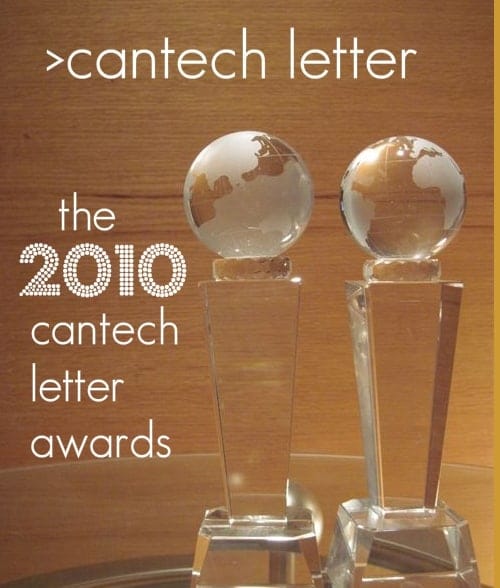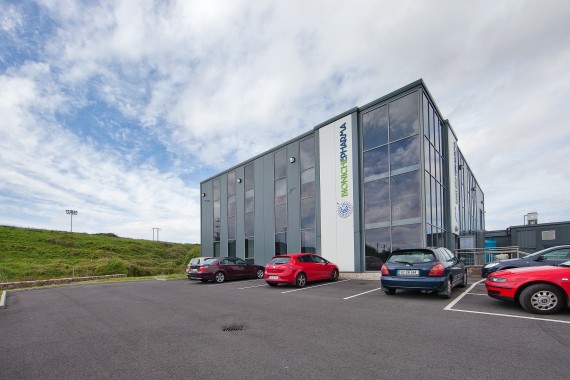
 When we decided to hold the first ever Cantech Letter Awards we were immediately faced with some tough choices. How many categories should there be? Which companies should be eligible? Should we simply take the ten best performing stocks and let our readers vote on them?
When we decided to hold the first ever Cantech Letter Awards we were immediately faced with some tough choices. How many categories should there be? Which companies should be eligible? Should we simply take the ten best performing stocks and let our readers vote on them?
What about revenue growth, is that more important than share price? Perhaps a combination of the two? Should a percentage gain in either be weighted more heavily to larger stocks?
In the end we decided on two categories: Canadian Technology Stock of the Year and Canadian Technology Executive of the Year. We also invited a panel of judges to help us to not only choose the winners, but also the candidates.
The judges, including yours truly, considered share price, revenue growth, important milestones and partnerships. Any stock in the TSX and TSX Venture Technology, Cleantech and Life Sciences sectors was eligible. If you read Cantech Letter you’ll recognize the names of the judges; Kirk Exner of High Tech Venture Capital, Ron Shuttleworth of M Partners, Adam Adamou of Caseridge Capital, Jim Letourneau of Big Picture Speculator and Saj Karsan of BarelKarsan.com.
The companies and executives listed below have all had great years. Over the holiday season our judges will weigh the evidence and we’ll report back to you with who they believe had the best 2010. In the weeks to come we’ll also provide you some defences of their choices. Judges are also allowed to defend write in candidates, which may have not gotten a majority to vote to make the list. Starting next week we’ll also give you a chance to be the judge. By voting in our upcoming poll we’ll give you a chance to determine which executive is Cantech Letter Executive of the Year and which company will win the first annual Cantech Letter Award for Company of the Year. For now we present you with the ten candidates, in no particular order.
1. SXC Health (TSX:SXC) – Mark Thierer
Price on December 31st, 2009: $28.65
Price on December 13th, 2010: $44.10
Percentage Gain: 54%
Four years ago, SXC Health was lost in the shuffle -a mid sized healthcare IT provider from Milton, Ontario with just over $80 million in revenue. Today, after aggressive acquisitions and organic growth, the company is an international healthcare IT King. SXC is a pioneer in the pharmacy benefit management sector, with revenues in excess of $1.4 billion. Recently named by FORTUNE Magazine as one of the 100 Fastest Growing Companies, SXC Health has become one of the biggest Canadian technology success stories in recent memory. In 2010, SXC reported consistently improved quarters. In Q3, their most recent, Q3 revenue grew $106.4-million, or 28 per cent on a year-over-year basis.
Click here for Cantech Letter’s interview with Mark Therier, President and CEO of SXC Health
2. Westport Innovations (TSX:WPT) – David Demers
Price on December 31st, 2009: $12.23
Price on December 13th, 2010: $19.69
Percentage Gain: 60.9%
“You know I’m excited about this…I need you to check my enthusiasm…” On June 3rd of this year Jim Cramer of CNBC’s Mad Money’s was positively gushing in an interview with Westport Innovations CEO David Demers. Cramer felt the political winds of change were behind the Vancouver based developer of natural gas engines. Demers, clearly not as prone to bombast as the volcanic host conceded that “The spill in the gulf is a wakeup call that we need to do something now.” That something, the adoption of natural gas as what Cramer called a cleaner “transition fuel” that could bring energy independence to the United States, will be helped along by Westport Innovations, which has already partnered with three of the world’s top four top engine makers. Westport got a little international flare when it was revealed that legendary investor George Soros had, by the second half of 2010, become its largest shareholder. It would have been hard to imagine such “A” grade exposure years ago. Founded in 1996, Westport grew out of a research project by Professor Philip Hill at the University of British Columbia’s Mechanical Engineering Department. Hill was developing a concept called high pressure direct injection (HPDI) of natural gas. In 1994, through UBC’s University-Industry Liaison Office, Hill met current Westport CEO David Demers. In 1995, with HPDI technology as its principal strategic asset, Westport Innovations Inc. was formed.
3. Electrovaya (TSX:EFL) – Sankar Das Gupta
Price on December 31st, 2009: $.83
Price on December 13th, 2010: $2.26
Percentage Gain: 172%
What was behind Electrovaya’s rise in 2010? The long answer is a more than a decade’s worth of pioneering work and 150 patents on its lithium ion battery technology. The short answer is Chrysler. On March 24, Electrovaya announced that it had been selected by Chrysler to supply the battery for a hybrid version of the Dodge Ram pickup. The Company also appointed former Chrysler CEO (and Windsor Ontario native)Tom Lasorda to help guide them through the process. While the automobile market is probably the most immediately addressable area for Electrovaya to commercialize its battery technology, some think the company is not limited to that sector. “Electrovaya is really just scraping the surface” says Puneet Malhotra, who covers Electrovaya for Dundee Securities. “There is always execution risk, but there are applications for Electrovaya’s technology in other areas. In fact they have already begun to demonstrate its viability in electric utilities in demonstration projects.” Could Electrovaya’s technology power the vaunted Smart Grid? Some think so. Electrovaya recently signed an MOU with a Japanese manufacturer of power distribution equipment named Nippon Kouatsu Electric to use Electrovaya’s battery storage systems for both stationary power and smart grid systems applications, initially targeted for the Japanese market. Electrovaya’s revenue is still small, but showed a healthy gain of approximately 48 per cent, up to $1,298,000 in Q3.
4. Constellation Software (TSX:CSU) – Mark Leonard
Price on December 31st, 2009: $36.75
Price on December 13th, 2010: $48.77
Percentage Gain: 32.7%
Formed in 1995, Toronto’s Constellation Software, which makes software for the public and private sector, is clear about its strategy. The company grows through acquisition, looking to acquire best of breed companies across different verticals. Constellation is involved in various niches on the public and private side from software for housing authorities, transportation agencies, and software for large home builders. On the strength of this strategy, the company grew its 2010 revenue 50% over the nine months they have reported to date, to $459 million from $306 million. So far this year, Constellation has created over $200 million in market value for shareholders, as the company’s market cap topped a billion dollars late in 2010.
5. Bioniche Life Sciences (TSX:BNC) – Graeme McRae
Price on December 31st, 2009: $.56
Price on December 13th, 2010: $1.44
Percentage Gain: 157%
For years, Belleville, Ontario’s Bioniche Life Sciences (TSX:BNC) was better known to your veterinarian than your doctor. Bioniche, which formed in 1979 to develop veterinary bio pharmaceutical products, received worldwide attention two years ago when it received a Canadian license for Econiche, the world’s first cattle vaccine against E. coli. Sales of Bioniche veterinary products such as FOLLTROPIN-V, used for the induction of superovulation in reproductively mature heifers and cows, and SETTLE®, a endometritis therapy for broodmares helped establish the company as a public entity that has grown from $27 million in revenue in 2007 to more than $45 million in fiscal 2010. Bioniche’s animal health products sales have been slipping of late, but many investors aren’t too worried. As it turns out, the company’s move into human health may be much more lucrative. In the early 90’s Bioniche established a human health division, and the results of this venture are now, finally, paying off. Since late 2009 shares of Bioniche have rallied from just over $.40 cents to a recent high of $1.80 on October 15th. The reason? Urocidin. Urocidin is a product Bioniche has developed to treat non-muscle-invasive bladder cancer that doesn’t respond to current first-line therapy.Bioniche’s fiscal year is not aligned with the calender year, but the company reported double digit growth in 2010; highlighted by Q3’s $15.6-million, which was an increase of $8.2-million, or 111 per cent, over the same period in fiscal 2009.
6. Glentel (TSX:GLN) – Tom Skidmore
Price on December 31st, 2009: $13.40
Price on December 13th, 2010: $26.50
Percentage Gain: 98%
Glentel’s story has more than its fair share of twists and turns. The Company’s roots actually go all the way back to an auto glass shop in New Westminster, BC that was founded by the Skidmore family, in 1946. Fast forward to 1985, and Glentel became the original service dealer for communications giant Rogers; a move that seems less unlikely when one recalls the mania and prestige that surrounded having an actual working phone in your car in those salad days of cellular. By 1989, the little glass shop was called TCG and it had just completed a purchase of a company called Glenayre Electronics, which it renamed Glentel.
Glentel entered the cellular age when phones were the size of handbags and twice as expensive. But even in its early days it was a timid offering. The Company was divided into two business units. One was the retail division. Missteps by its other side, the business division, caused a major roadblock that would ultimately set The Company’s fate in motion. As the dot-com era was ramping up; Glentel made major bets on fibre-optics and wireless services that never panned out. A deal made with NASDAQ high-flier Jaws Inc. (NASD:JAWS) epitomized the era. On July 12 1999, the two companies made a deal to “explore sophisticated wireless data services”. Just two years later, JAWS was put into receivership. Glentel fared better, but it wasn’t doing well; its stock fell from $13 to pennies as the wireless sector was hit particularly hard.

Whether its hand was forced or not, Glentel’s new focus on its retail side of its business meant it finally started getting things right as the millennium closed. After opening the first of its “Wireless Wave” retail outlets in 1997, The Company began to focus on retail operations -and the strategy worked. Glentel’s retail presence often took the form of smallish kiosks in high-traffic malls. Canadians liked the service, which was informal, quick, and knowledgeable. By the summer of 2003, Glentel grew to sixty four of its “Wireless Wave” stores in malls. By 2008 it had over 250 corporate locations (including its Tbooth/La Cabine T and Wireless etc.brands). Not surprisingly, Glentel’s revenue took off too; growing from $45.6 million in 2000 to $308 million in 2009. In 2010, Glentel experienced double digit growth in each of the three quarters it has reported to date. What’s more the company has consistently increased its dividend, and even declared a one time special dividend of $.36 cents per share this past October.
7. Innergex Renewable (TSX:INE) – Michel Letellier
Price on December 31st, 2009: $5.50
Price on December 13th, 2010: $9.77
Percentage Gain: 78%
Over the past few years a lot of Cleantech deals that sailed high on promise have crashed on the cold shores of reality. Innergex looks like one of those that will emerge from the rubble. Based in Longueuil, QC, The Company develops, owns and operates run-of-river hydroelectric facilities and wind projects. Innergex now operates seventeen facilities that generate 325 megawatts of power. The Company’s balance sheet benefited greatly from three important projects that came online within fiscal 2009. These three projects are part of seven Innergex hopes to bring online before 2012. The Company expects these additional projects to bring their total power generation to 529 megawatts.
8. Pareto (TSX:PTO) – Kerry Shapansky
Price on December 31st, 2009: $1.10
Price on December 13th, 2010: $2.32
Percentage Gain: 111%
The stock that ranked #1 on Cantech Letter’s Dividend Ten List, Toronto’s Pareto only began to declare a dividend in 2008. But the Toronto based company, which provides shopper marketing solutions, has been making up for lost time. The Company’s increased its dividend of $0.015 per share to $0.02 in June, and then increased it to $0.03 in August. Pareto also threw in a special cash dividend of four cents per share in January. Pareto has seen strong double digit top line growth in 2010, particularly in the company’s most recently reported quarter Q2 and Q3, which were up 51% and 45% respectively.
9. Gennum (TSX:GND) – Franz Fink

Price on December 31st, 2009: $4.50
Price on December 13th, 2010: $7
Percentage Gain: 56%
Founded in 1973 as Linear Technology, Gennum is the back end that makes 3D TV happen. The company’s history is in semiconductor products for the video broadcast industry. Through acquisition and in house innovation Gennum has kept an aggressive stance with products that have kept it at the bleeding edge of broadcast technology. Many of Gennum’s products and services are complex, but the company’s mission boils down to making sure that the myriad of data communications it enables do not lose signal integrity. At the recent International Broadcasting Convention show in Amsterdam, Gennum released the GX3290, part of a 3G family of non-blocking crosspoint switches that target the increasingly complex demands of video routers, video production switchers and multiviewers. Gennum’s Q3 revenue was a 61 per cent over the third quarter of 2009, and the company’s fifth consecutive quarter of revenue growth.
10. Sandvine (TSX:SVC) – Dave Caputo
Price on December 31st, 2009: $1.29
Price on December 13th, 2010: $2.63
Percentage Gain: 104%
When Sandvine President and CEO Dave Caputo picks up a newspaper these days it must be hard to stop smiling. Two contentious, consumer-related technology issues keep landing on editorial pages, and his company is in the sweet spot for both.
The first has to do with what the FCC calls “Bill Shock”. It’s estimated that thirty million Americans have experienced a bill more than $50 larger than what they anticipated, but were not alerted to beforehand. Under new rules the FCC is proposing, consumers would have access to simple alerts and easy to find tools to manage their accounts better. It would also “…require wireless phone companies to obtain customer consent before charging for services that are not covered by their regular monthly service plan.”
Northern Securities analyst Sameet Kanada believes these measures are good news for Sandvine, because tools the Waterloo based company has been building for years address these very issues.
The other issue can be described with a host of technical terms like buffer overflow, stateful packet inspection or deep-packet inspection. Or it could be described with just one: Netflix. The growth of Netflix is bringing debate about bandwidth management to a head. The issue? Netflix uses a ton of bandwidth, and that supply is not unlimited. And since Netflix has transitioned from a mail order business model to a primarily online one, it has had a staggering impact on bandwidth usage. One report estimates that Netflix now accounts for twenty per cent of peak bandwidth use. Different legislative jurisdictions are dealing with the issue differently. To try and manage congestion for Canadians, the CRTC approved usage based billing in May of this past year. But these types of issues are going on worldwide, and Internet service providers are scrambling for ways to advance their technologies. As tech journalist Farhad Manjoo pointed out recently” American broadband is pretty crummy. Unlike in other countries, our Internet plans haven’t been getting faster, cheaper, and more widespread” Manjoo wonders: “If 2 percent of Netflix customers account for one-fifth of the traffic on North American broadband lines, what will happen when more and more Netflixers begin to watch movies during peak times?”
Many investors believe Sandvine may be able to help US service providers avoid the worst scenarios, or at least curtail the problem until more capacity becomes available. Sandvine sells technology that gives service providers a window into the world of their chaotic traffic. The buzz-phrase in this space is “deep packet inspection”, a technology that enables wireline and wireless networks to target data-overload issues. Sandvine’s growth is clearly part of a larger trend; Infonetics Research estimates that deep packet inspection will grow from just over $200 million in 2008 to a more than $1.5 billion business by 2013.”
Sandvine has been signing service providers left and right, with five new contracts announced earlier this month. The stock has responded, closing at a fifty two week high of $2.82 on December 6th. For the nine months ended August 31st, Sandvine’s revenue was up about 47% to $54.4 million.
The Cantech Letter Awards are supplied for information purposes only. Cantech Letter makes all reasonable attempts to ensure the timeliness and accuracy of the information provided in our website. However, there are no representation or warranties as to the accuracy, reliability, completeness or timeliness of such information. This information should not be construed as investment advice and is not intended to solicit the buying or selling of any stocks mentioned. Investors should complete their own due diligence before making any investment decisions.
Comment
One thought on “The 2010 Cantech Letter Awards: The Nominees”
Leave a Reply
You must be logged in to post a comment.






 Share
Share Tweet
Tweet Share
Share




GLENTEL-all the way. A remarkable story of the little company that could! Glentel is no longer the best kept secret on the TSX!